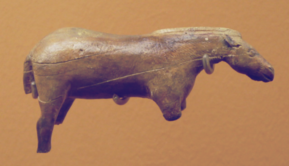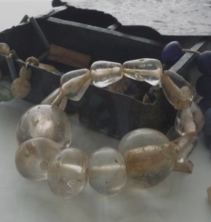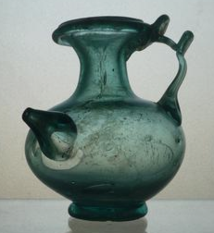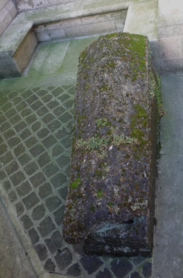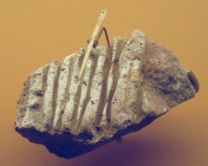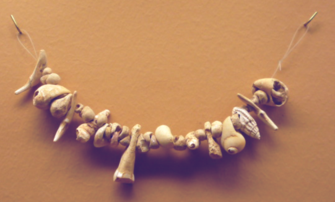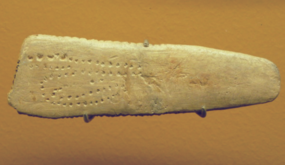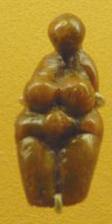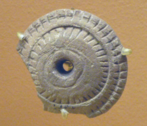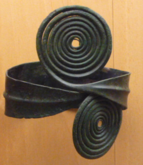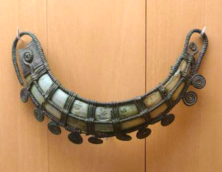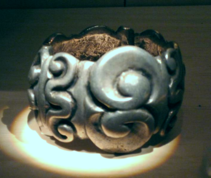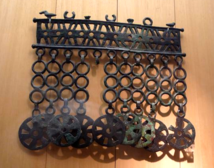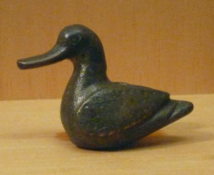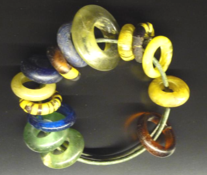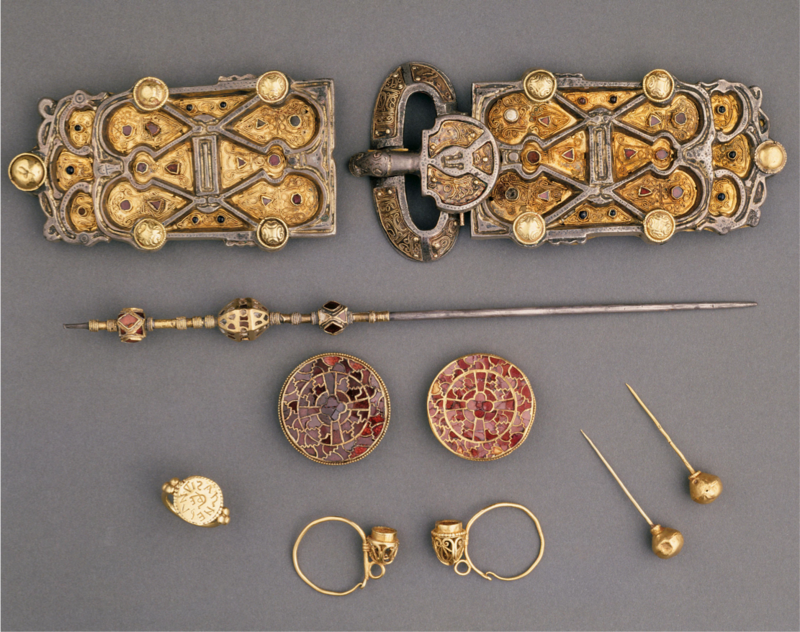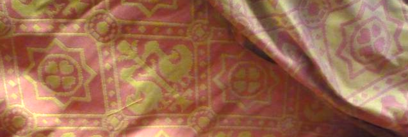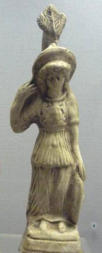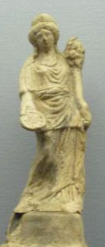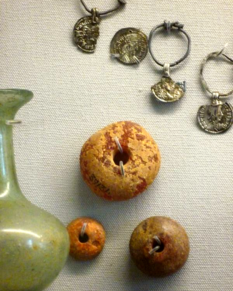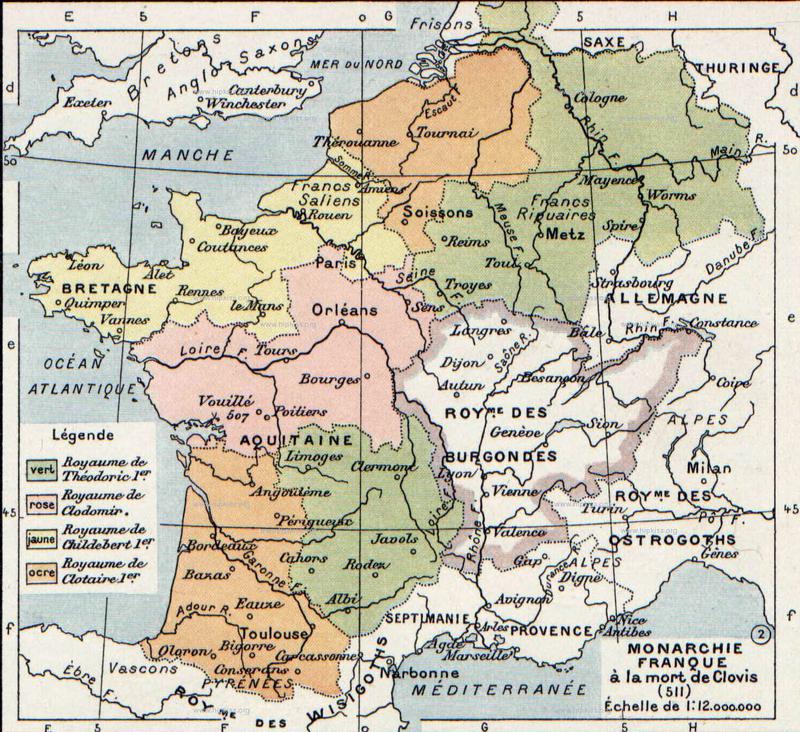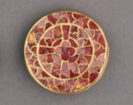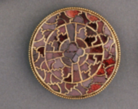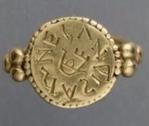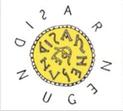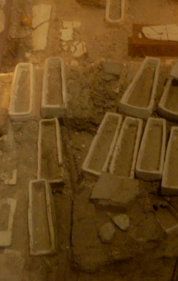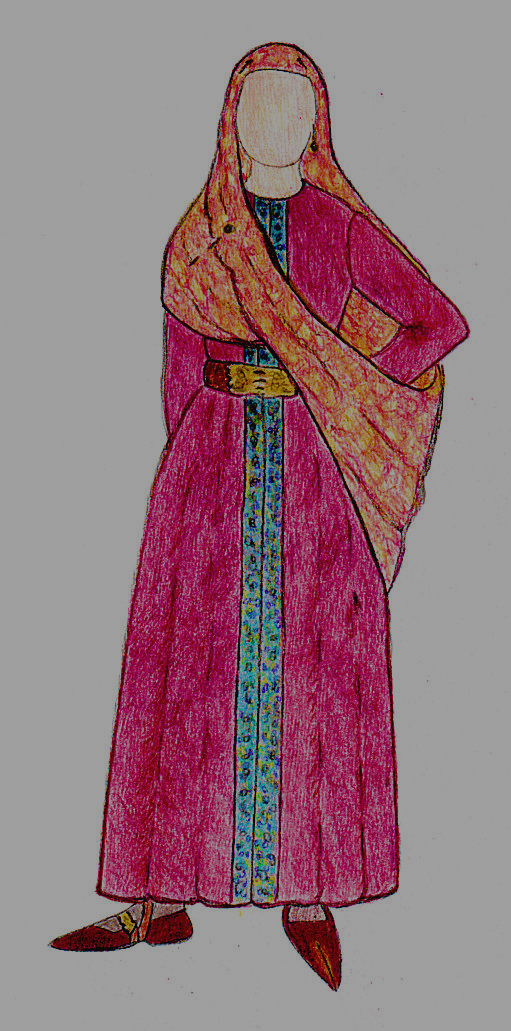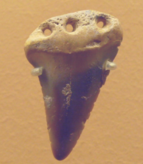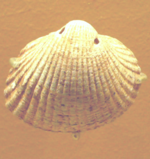National Archeological Museum of France
Musee d'Archeologie Nationale de France
Women's Travel Abroad
For Women About Women By Women
Emerging from the Line A RER train station at the Saint Germain-en-Laye I see the museum to my left. I am glad it is nearby so I can save my energy for exploring the vast exhibit rooms. This museum has some of the most ancient and valuable French artifacts. I have been told most of them are on display in glass cases. The modern trend for hands-on activities has not been implemented here. That is is fine with me. I like knowing they are safely stored for future visitors to enjoy.
All are priceless. It would be impossible to replace them. I am looking forward to seeing the Venus figurines, Greek, Celtic, and Roman goddess statues, and the grave goods of Aregunde, a 6th century Merovingian queen of the Franks. I also expect to find some wonderful surprises. I suspect there are artifacts from ancient French history that I am not at all familiar with. There should be lots of interesting artifacts to see at this museum.
Going through the arched entry to the museum I am greeted by a security guide to my right. Straight ahead I get a glimpse of the chapel and courtyard. On my left is the door to the museum. I leave my bag in a locker and walk down the hall and go into the store to buy a ticket. The museum shop has prehistoric items for sale including replicas of the Venus of Brassempouy.
There is a good selection of books about archaeology, in French for adults and children. The salesman finds me an English version of The Musee des Antiquities nationales Saint Germain-en-Laye that has beautiful color photos of the museum's artifacts. I pay for the book and ticket and proceed down the hall to a large restroom. It seems to be the only public facility in the museum.
Seeing her for the first time I am enchanted and amazed by her petite size. The enlarged photo of her in my guide book simply does not capture her demureness. The only remaining part of this Venus sculpture, the head, is in reality no bigger than the end of my thumb.
The "hooded lady" Venus, carved out of ivory from a woolly mammoth tusk, dates to the Gravettian period (29,000 - 22,000 BC) in France. The head was found in 1894 AD on the porch of the Grotte du Pope in Brassempouy, an archaelological site in southern France.
After walking past many exhibits I finally arrive at the Venus figurines. Mounted separately, from a larger collection of Venus figurines on a feminine pink background, the Venus of Brassempouy appears to be more like a modern 21st century carving than her voluptuous Paleolithic sisters. Even without the rest of her body I can imagine this Venus as being slim rather than rotund. She is daintily sculpted with stylized face features and embellished with a decorative hood which, in her time, would probably been made of some kind of woven material. Her slanted eyes, rounded cheeks, large nose, pouting mouth, and elongated neck set her apart from every other Venus found in France so far.
Scattered throughout the museum are many other remarkable beautiful objects d'art as well as purely functional artifacts. Another famous mammoth ivory sculpture, from the upper Paleolithic Magdalenian culture (17,000 - 12,000 BC), also enchants me. This almost entirely intact 3-dimensional figurine of a horse is carved with exquisite detail. The artist used incised lines to clearly define the horses' mouth, eyes, nostrils, ears, mane, and muscles. The sculpture was found in the cave of Les Espelugues at Lourdes, Hautes-Pyrenees, France.
Another similar small, portable art piece discovered in the Aurignacian levels of he Lartet rock shelter at Les Eyzies-de-Tayac, Dordogne, France also has detailed marking. This mammoth ivory sculpture, engraved with dots and notches and painted with red ocher, is thought by some scientists to be a system of notation used as a lunar calendar. While the scientific evidence for this claim is inconclusive several authors of prehistory novels, Jean Auel's Earth's Children and Joan Wolf's Tribe of the Red Deer series, have used the 'calendar' in their stories.
Interspersed with more useful blades, tools, and pottery dating from the Paleolithic to the Neolithic periods are prehistoric artifacts of personal adornment. I find bone needles so necessary for the creation of practical and decorative clothing. These are perhaps the earliest indicators of the French penchant for 'haute couture'. There is also a good collection of jewelry made from shells, animal teeth and bone, ivory, and clay.
Jewelry during prehistoric time was made from a variety of natural materials. The first pieces, usually necklaces, were made of animal teeth and shells. In later periods beads were hand sculpted from clay or carved from woolly mammoth ivory. Precious stones said to be imbued with magical power, like amber and jade, were also used to embellish or create entire pieces of jewelry.
Judging from these artifacts it seems difficult to me to determine if gold and silver were considered more valuable than bronze or iron, as it is today, because all of the articles made from these metals appear to be created with great skill and artistry. However, large hoards of the metals, buried underground at specific sites or in graves in France, suggest each metal was considered highly valuable.
The one thing that does appear certain to me is modern France, as we know it today, is in part due to the successful control of fire for extracting metal from ores and shaping it into weapons for war, vessels for storage, and jewelry for status. I often see the decorative influence of Celtic geometric and circular motifs in the windows of contemporary Parisian shops and stores.
Trading relationships increased in importance. Much of the affluence of ancient Gaul was dependent on the import of resources, material objects, and skills from neighboring areas. Ownership of material goods factored into determining a persons' status within her group. Jewelry and household items appear to have been significant indicators of rank among ones' relatives and friends.
During this time tribal societies became more stratified and complex. Leaders were typically chosen because of their ability to defend territorial borders or acquire new land through combat in battle or war. Weapons for war and tools for cultivation became ever more sophisticated. It is probable metal smiths created equally as many blades for swords for battle as they did sickles for farming.
For millions of years stone had reigned supreme. With the discovery smelting ore Gaulish France quickly created a distinct style of decorative metal art. Sometimes referred to as Celtic motifs the decorative style included animal imagery and geometric designs. Horses, ducks, swirls, and spirals were added to both functional and frivolous articles. Back then most of the motifs had some kind of powerful spiritual or significant symbolic meaning. Many of these motifs are still used today by contemporary designers. The bronze arm band and boar tusk pendant from a woman's burial, (La Columbine, 1200 BC), bronze pendant (Forest of Moidons, 500 BC), and silver bracelet (Nimes, 200 century BC) attest to the timelessness of Celtic craftsmanship and artistry.
Circular Solar Disk
In olden times people felt gold was the purest metal. Gold is a rare but many beautiful ancient artifacts are made from this metal. Once found gold is easy to mine, melt, and forge. Its' shine and color evoke images of both fire and the sun. In these artifacts from a find at Villeneuve-Saint-Vistre, Marne (1500 - 1200 BC) gold was shaped into goblets and engraved with geometric and circular designs.
Many scientists think the circular shape, called a solar disk, represents the sun. I find it is one of my favorite images. I often use a circle inside a circle in my jewelry. To give the piece a celestial feeling I make the inner circle twirl inside of the outer circle. I prefer to use metals and materials other than gold for my designs. They are more readily available and affordable than genuine gold.
The Celts were largely responsible for much of the ancient art of the rich and powerful states of Independent Gaul. The artisans of La Tene culture, which flourished in northern France from the 5th to 1st century BC, created many beautiful pieces of functional art. For the people of this society material objects were made to be used.
Masterful artisans were believed to know the essence of matter and had the ability to magically transform elements from a raw state to a finished product. They excelled in working metal, pottery, and glass. With their keen understanding of the arts of the fire they forged a heritage of French design and expertise still in use today.
Looking at these beautiful works of art is a humbling experience. The level of sophisticated design and mastery of technique is apparent in every article on display. I can easily imagine buying the silver bracelet (Nimes, Gard, 3rd century BC), clay bowl, or glass beads (Sanctuary of Mathay, Doubs, 1st BC) in a 21st century store or on an internet website. Yet the ancient Romans viewed these creative people as primitive and barbaric.
A guard informs me the museum is closing for lunch so the staff can eat lunch. I stop in the restroom on my way out of the museum. Then I walk through the arched entry and over the bridge to eat my picnic lunch in the park. On my right is a fountain, a gravel walkway, grassy quadrant, and blooming flowers. Many other people are also in the park enjoying the brisk, sunny afternoon.
Finding an empty bench I sit down and open my lunch sack. YUM! I made my favorite ham and cheese sandwich on a whole grain baggette. I also have juice and an apple. According to the book I purchased at the museum shop, The Musee des Antiquities nationales Saint-Germain-en-Laye by Patrick Perin, my lunch is almost Neolithic. However, instead of yeasty bread, smoked ham, and Elementhal cheese I should be eating a sandwich made of unleavened bread and boar meat with no cheese. Pigs and wheat had been domesticated by the Neolithic but yeast and cheese were introduced later. My beverage should have been some kind of herbal tea. The only thing I get right right was the apple. Also, I could have added a trail mix of berries, Hazelnuts, and acorns as a snack.
During this break I have about an hour and a half before the museum reopens. There is still so much left to see at the museum. Luckily my entrance ticket is good for the entire day. I want to go back and explore the Roman and Merovingian exhibits. I also want to visit the bookstore again before I leave the museum. So I head back into the museum, stop once again in the restroom, show the guard my ticket, and proceed up two flights of stairs to the Roman rooms to pick up French history where I left off.
Although the south of France had been governed by Rome for several hundred years the people who lived in northern France wanted their country to remain free of Rome. Independent northern Gaul was a huge area with an abundance of forested land for timber, arable land for growing grain, grazing land for raising animals, and deposits of valuable metals (copper, silver, and gold) waiting to be mined. In 52 BC Julius Caesar turned his eyes toward Gaul looking for untapped resources to fund his political campaign.
After his victory over the Celts at the Seige of Alesia all of Gaul came under Roman rule. Thousands of barbarian survivors of this battle were killed, deported, or sold into slavery. Their fierce chief Vercingetorix was sent to Rome to be imprisoned, shamefully paraded through Rome, and publicly executed by Julius Caesar. Many of the Gaulish people did not willingly adopt Roman culture. Over the next four hundred years of Roman rule other Celtic warriors, including women, continued to rebel and fight the Roman army.
After the successful conquest of Gaul the Roman Senate divided Independent Gaul into three separate provinces - Belgica, Celtic Gaul (Lugdunensis), and Aquitania. Each of these provinces were then broken up into smaller areas to make them more easy to govern. Rome sent administrators and their families to the provinces to civilize the barbarians. It was their job to show Gaulish residents how to be good Roman citizens.
Previous to the Roman occupation of Gaul most Celtic women had a considerable amount of autonomy. Women had a say in who they married and could divorce when they wanted. Certainly motherhood was an important part of their contribution to society but it was not the only role they played. Many of them owned property and were actively involved in their communities settling disputes, sitting on war councils, and serving as religious leaders.
Battle of Alesia
Roman women, on the other hand, were entirely under the control of their father, brother, uncle, or husband depending on their marital status. Women were expected to marry whomever their paterfamilias chose, could not own property in their own name, and needed his permission to divorce. Their most important roles were to produce legitimate sons and educate them to be honorable Roman citizens. Daughters were often considered a liability and sometimes hastened to an early death by being exposed to the elements shortly after their birth.
The women of influential and affluent Roman men spent a great deal of time managing their home. Sending women to the colonies was one of the most powerful strategies and effective techniques Rome used to enculturate the natives. Roman women were voracious consumers of household goods and demanded the best quality products. For them conspicuous consumption was an empowering and entertaining activity.
Over time some Celts adapted to Roman culture. When the Roman army was relocated to other parts of the empire local men were assigned administrative positions of authority. As an official representative of Rome it was his responsibility to ensure that all public buildings were built using Roman architectural practices, government business was conducted in Latin, military quotas met, and yearly taxes paid.
In his home he was expected to live the Roman life style and display art which reflected his appreciation of Roman design. Fragile glass vessels and silverware would decorate this Gallo-Roman man's table. Imported wine and fish sauce would be served with every meal. Exquisite glass jewelry would adorn his women folk. There might even be an Epona statuette, the guardian goddess of Roman cavalry soldiers, on his mantle.
As a member of the Gallo-Roman ruling elite and a Roman government administrator he was expected to perform religious services for his family in the privacy of his home and officiate at religious ceremonies in public temples. Gallo-Roman men and women had a pantheon of gods to worship imported from all over the Roman Empire.
He might worship the Roman gods Mercury or Jupiter while the women of his family may pray to the Roman goddess Ceres, Greek goddess Athena, or Egyptian goddess Isis for fertility and abundance. However, none of them would have prayed to a Druid god or goddess or the Christian god on pain of death. It was against Roman law.
Judging from the cases and cases of Roman, Greek, and Egyptian goddesses I see at this museum the law was relatively effective at discouraging the worship of the Druid and Christian religions. Very few artifacts exist from either of these cults. However, it is important to remember Druidism religious services were usually performed in forests or glades where devotees worshiped natural elements. Also it is not feasible to move a huge stone circle, like the one at Carnac which may or may not be a Druid temple, into a museum.
Christian artifacts from Roman times are difficult to find here as well. Early Christians believed religious images were profane. The only remains of Christianity on display in the museum are chi rho symbols carved on fragments of the coffins of believers. Devoted converts, persecuted and sainted for their beliefs, spread the gospel of Jesus Christ throughout the Roman Empire for almost three hundred years before Emperor Constantine legalized Christianity in 313 AD with the Edict of Milan.
From the fall of the western Roman Empire in 476 AD to the Catholic baptism of king Clovis I in 496 AD, most Gaulish people were free to openly practice the religion of their choice.
Pagan, Druid, and Christian symbols were shaped into pieces of jewelry for women to wear or carry with them. The icons were believed to be imbued with magical powers.
By 509 AD, through a series of battles with Roman military forces and other warrior kings, Clovis I succeeded in becoming the supreme ruler of the Franks and consolidating Roman Gaul into a unified Frankish kingdom. Clovis I established his primary residence and court in Paris. His conversion to the Catholic religion was the beginning of the end of religious diversity.
His devout wife, Clotilde, spread Christianity and Catholicism throughout the land. She worked closely with the sainted Genevieve to enlarge the Catholic congregation of Paris and to build the Church of the Holy Apostles in the capital city. This may have been a very daunting task considering the fact almost ninety-five percent of Paris practiced Paganism or some other form of religion.
Every day life in Francia was still quite Roman. The king and queen Clotilde lived in the Roman palace on the Ile de Cite. Queen Clotilde and Genevieve would have spoken Latin and dressed as modest Roman women. However, unlike the more austere Genevieve, queen Clotilde would have set her table in the Roman manner and worn jewelry in the Roman style.
King Clovis I and queen Clotilde had six children - five sons and one daughter. Before he died, sometime between 509 and 513, Clovis I divided his kingdom between his four surviving sons - Theoderic I, Chlodomer, Childebert I, and Clotaire I to ensure the continuation of the Merovingian dynasty. This division of land created the four distinct political areas of Paris, Rheims, Orleans, and Soissons. Both king Clovis I and queen Clotilde, who died in 545 AD, were interred at the Basilica of the Holy Apostles (Saint Peter and Saint Paul) in Paris with their beloved sainted Genevieve.
The rule of king Clovis I and Clotilde's sons was extraordinarily violent. Greedy to own even more they warred with each other until only Clotaire I was left alive. In 558 AD he reunited the separate kingdoms. However, before his death Clotaire I redivided the land among his sons according to the Salic Law of male inheritance. This policy of sons inheriting equal shares of their father's property led to hundreds of years and generations of family infighting and territorial war.
The Salic Law, codified by king Clovis I, specifically stated a woman could not inherit a throne or kingdom. However, women could inherit 'movable' property such as income, weapons, tools, household goods, clothing, and jewelry. The female relatives of Frankish kings were often exchanged or forced into political marriages expressly for economic purposes. Some royal women were even kidnapped against their will and held as hostages until a dowry was paid.
In 1959 a women's tomb was excavated in the crypt of Saint Denis Basilica, Paris. A gold signet ring with the Latin inscription ARNEGUNDIS REGINE was found in the limestone coffin. This discovery led researchers Edouard Salin and Michael Fleury to attribute the grave to the 6th century Frankish queen Aregonde, the third wife of king Clotaire I and mother of king Chilperic I.
Aregonde, the sister of Ingund, one of Clotaire I other wives, was born in Thuringa to King Baderic between 515 and 520 AD. She was about five feet in height. The skeletal remains found in her sarcophagus suggest she had contracted polio in childhood and may have limped. They also indicate she suffered from arthritis of the spine as an adult. Her son was born when she was around eighteen years old. She survived her husband by almost twenty years dying at about the age of sixty in 560 AD.
From the high quality of the grave goods buried with Aregonde it is clear she was a wealthy, respected early medieval woman. This is an extremely important find because her clothing and jewelry reflect the development of a distinct Frankish style of design. It is also a very rare find because soon after this queen died Merovingians stopped burying their deceased with valuable material objects and donated them to the church instead.
Veil Pins
Ornamental Veil Pin
Cloisonne Brooches
'Basket' Earrings
AREGUNDIS
REGINE
Insignia Ring
Belt Buckle and Clasp
Finally, the basket, twill and diamond weaving patterns and blue madder dye used to create the textiles for her linen shroud and wool under garments were of local origin and were constructed in the Frankish style. However, the silk fabric for the purple coat and red and gold veil were woven and dyed in the Orient and Mediterranean in the Roman fashion.
Recent research conducted in 2012 by Sophie Desrosiers and Antionette Rast-Eicher has literally unearthed some new information about the treasures found in queen Aregonde's casket. By analyzing the composition of her jewelry and remnants of fabric found in the grave these researchers were able to shed new light on her burial. They presented their findings at the 13th Biennial Symposium on the Textile Society of America in Washington, DC. (Luxurious Merovingian Textiles Excavated from Burials in the Saint Denis Basilica, France in the 6th - 7th Century, http://digitalcommons.uni.edu/tsaconf).
Three interesting pieces of information were revealed. First, it was thought her dress was knee-length to show off her red pointed-toe leather shoes and silver- buckled cross-garters. Looking more closely at the fabrics they found her dress was ended just above her shoes. Second, the garnets set in her cloisonne brooches had come not only from Portugal and Bohemia but from sites as far away as India and Sri Lanka.
The blue edging on the coat cuffs is silk samite imported from Persia. Above the cuffs was an embroidered band of gold rosettes outlined with circles. The veil was made in the the east but the patterns have a Celtic look. Imported golden silk thread was used to decorate her leather belt. The queen's shoes and garters were restored by the Shoe Museum, Lausanne, Switzerland.
The museum guard announces the museum will be closing in thirty minutes and everyone must make their way to the exit. Fortunately I am in the last room I wanted to visit so I hurry off to the bookstore for one last look at the merchandise. The museum cast of Venus of Brassempouy is lovely and tempting but I decide not to buy her this time. There is only ten minutes left before I have to leave so I rush into the courtyard for one more look around.
As I walk out of the museum and over the bridge that spans the moat I am surprised to find another burial site. This gallery grave is a reconstruction from one found at Conflans-Sainte Honorine in Yvelines, France. It dates from the late Neolithic period (3300 - 2800 BC.) in France. This particular tomb in the moat and the Merovingian sarcophagus outside the doors of the chapel in addition to an early Neolithic grave and replica of the Merovignian crypt at the Basilica of Saint Denis inside the museum remind me of just how many of the artifacts were unearthed from human burial sites.
I am finding it difficult to close the door on this experience. Even though I am completelly exhausted I want to go right back in and see every room again. In all honesty I will confess this is my third visit to the National Archeological Museum. Every time I come here I pay my respects to the darling of the museum, the Venus of Brassempouy.
Then I proceed to explore the museum all over again. Many of the artifacts I see are my familiar favorites but there are always new objects d'art and special exhibits of artifacts from the museum's huge archival collections. It is very likely I will come here again on another trip to Paris. There is really no place like it anywhere else in the world.
Just a note in passing, the day I visited the Roman rooms were being closed just as I arrived to view them. A kind guard allowed me access to the rooms for a few minutes to take photos. Their website recommends visitors call in advance before they visit the museum to find out which rooms are closed.
The museum website translates well from French to English with the Google translator program. On the website you will find information about visiting the museum, previews of special expositions, events, and activities, a history of the castle and school, and a catalog for books you can purchase in the museum shop. There is a portal for viewing the collections of the museum and a virtual tour of the newly remodeled Gallic room. Under resources you will find the names, phone numbers, and email addresses for department curators and administrators and an extensive list and links to archaeological locations throughout France including prehistoric caves, Neolithic and Gaulish religious sites, theme parks, and Roman cities. The museum also has an extensive library available by appointment for professionals, researchers, and Master's students fluent in reading French.
Copyright 2017 Creative Travel Publications, LLC
Destinations
The Chateau is on the site of an early medieval fortified lookout built by Louis VI between 1122 to 1124. The quadrangle keep, hall, and moat of the Grand Chateau were added later. Saint Louis, Louis IX, added the Petite Chateau and Royal Chapel in the 1220's. The beautiful chapel is where Louis IX and his queen, Eleanor of Aquitaine, kept their holy Christian relics until they moved them to Sainte Chappelle, Paris in 1248.
It was burned down by English troops in 1346. Between 1364 and 1367, Charles V rebuilt the chateau. Another building spree, by Henry II in 1557, lead to reconstruction of the Grand Chateau and the addition of another new chateau and gardens as an additional residence for his court. Louis XIV and his mother, Anne of Austria, spent part of his childhood here until in adulthood he finally moved to Versailles in 1682 taking his courtiers with him.
The property was confiscated by the Republic during the Revolution. From 1793 until 1861 the Chateau was used as a national prison, hospital, and military school. In 1862 emperor Napoleon III made the chateau into a public museum to house his collection of ancient artifacts. Since then a research library, photographic workshop, and studio for making casts have been added.
The National Museum of Archaeology was originally called the Museum of National Antiquities. It is a virtual treasure trove of French archaeology and artifacts. On display her are lovely statuettes of female goddesses, tools typically used by women, and beautiful objects of personal adornment dating from the Paleolithic to Carolingian eras. I walk over the pedestrian bridge passing over the moat of the 16th century Grand Chateau.
Traversing the same hall I come upon a museum guide who takes my ticket and signals that I am to go to turn left and go up stairs to the gallery. At the top of the first flight of the stairs I come upon a life size two-dimensional clay sculpture of a bison. It is an exact replica from the small cave of Tuc a'Audoubert, Ariege, Dourdodne in the Pyrenees mountains of France. According to the potter Jayne Shatz the original bison were sculpted from an existing mound of clay. She says the artist actually left their own fingerprints in the wet clay.
Climbing a second set of steps I come upon a large room with even more prehistoric artifacts. The first time I visited here in 2011 the written material equated all the tools and artistry of the paleolithic era to the Cro-Magnon people. Now, two years later, Neanderthals have taken center stage as the inventive, creative people of prehistory. Museum placards tout their vast technological and artistic contributions.
Wandering around the room I see flint tools from the Levallois-Perret, an enormous set of auroch antlers, three-dimensional models of prehistoric life. On the walls is general information about the displays. Each piece is numbered. However, the book I purchased does not show everyone of them. I realize the only way to describe all of them separately would be in a catalog. It would weigh tons - literally!
Exhausted by all these wonderful artifacts I decide to take a break. Places to sit down in this museum are reserved primarily for the museum guards. I manage to locate a chair and check my photographs. I want to make sure I have a perfect image of the Venus of Brassempouy before I venture into the next rooms. Not satisfied with my image of her I backtrack and start taking more photos.
Close on my heels is a guard. As I take my photographs he hovers behind me. The guard appears uncomfortable with my obsession with the "hooded lady". I can hardly blame him. It is one of the museum's prize possessions. Regretfully, I say goodbye to her and move on to move on to more Neolithic displays .
During the Neolithic, 6,000 to 2000 B.C. modern humans successfully domesticated grain and animals, mastered the crafts of weaving fabric on an upright loom, learned how polish flint, and turn minerals into metal objects. Useful tools, such as the scythe and plow, increased agricultural production.
Weapons of war, practical and decorative household items, and objects of art for personal adornment were created from the newly discovered bronze, a metal alloy made by combining copper and tin. A new era in Europe, the Bronze Age, (2000 - 600 BC) had begun.
People mastered knapping flint tools by the Paleolithic. They developed blades for a variety of purposes and created beautiful blades out of quartz and jasper.
Ivory from mammoth tusks was used for needles used to sew clothing from hides, decorating clothing, and stringing beads to make jewelry.
During the Paleolithic period, from 800,000 to 12,000 BP, we see early people (Homo erectus, Neanderthals, and Homo sapiens) flourishing in what we would consider an inhospitable environment. Their transformation from living in the warm climate of Africa to the frigid climate of Europe is astonishing. In Europe glaciers receded and reappeared regularly, huge cold adapted animals like the mammoth elephant and rhinoceros roamed over the tundra-like landscape, and warm, cozy caves and overhangs were the best places to call home.
To deal physically and emotionally with the changes they domesticated fire, practiced organized hunting, manufactured tools, and created beautiful objects of art. The social nature of their communal living appears to have lead to group killing and processing of animals for food and clothing and the aesthetic arts of painting, carving, sculpting, embellishment, and music in addition to the reverential burial of their dead.
Then everything, slowly changed again. Between 12,000 to 6,000 BP, the Mesolithic period, glaciers that had covered Europe receded for one last time and climate began to warm. Lush, green forests replaced the barren, brown tundra. Smaller, fleet of foot animals replaced the large, lumbering mammals of the Paleolithic. Following the herds of migratory herds of deer, horse, and bison made living in seasonal, mobile shelters a more viable life style. In the Neolithic period permanent shelters were constructed of timber, wattle, and thatch.
In the Neolithic period Homo sapiens developed a new technology and strategy for hunting. The bow and arrow gradually replaced the heavy, cumbersome spear.
Instead of openly stalking game in large communal groups they banded together in smaller hunting parties more often attacking from behind a bush or tree.
Polished Flint Axes
They are eating lunch or chatting. Some people are napping in the warm sun. Other people are jogging around the park grounds. I see couples embracing, moms pushing babies in prams, and dads playing football with their kids. The scene makes me ponder. Even if I am many miles from home people here seem much the same as those in the USA. I would see the same scene at my local neighborhood park in Minnesota.
You Are Welcome to Contact Me Personally With Comments or Questions

